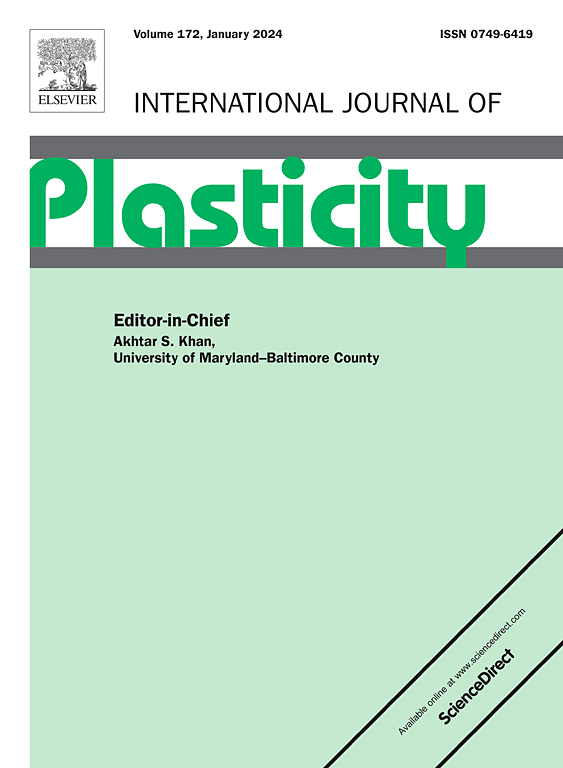基于物理的聚丙烯热粘塑性模型的大数据训练
IF 9.4
1区 材料科学
Q1 ENGINEERING, MECHANICAL
引用次数: 0
摘要
对数据驱动构成模型的研究表明,这些模型具有出色的能力,只需从数据中学习,就能对一般应力-应变响应做出高度准确的预测。在这里,我们证明了基于物理学的模型同样可以从依靠大数据的训练程序中获益。具体来说,我们采用了热机械耦合粘弹性模型[Anand, L., Ames, N.M., Srivastava, V., Chester, S., 2009.无定形聚合物大变形的热机械耦合理论。第 1 部分:公式。国际塑性学报》]描述了聚丙烯的大变形响应。它结合了基于机理的演化方程和高度的数学灵活性。在从 3 毫米厚的同素异形聚丙烯片材中提取的平面拉伸试样上进行了 100 多次恒速和应变速率跃变实验。使用环绕 DIC 测量精确的横截面积,同时使用红外摄像机监测表面温度场。实验的真实应变通常大于 0.8,温度和应变率范围分别为 25 至 85°C 和 10-4 至 100 s-1。对 100,000 个独特的随机实验组合进行训练,以确定所有模型参数。对训练(和测试)子集的大小和组成的影响进行了仔细分析,以确保较高的泛化能力。结果发现,基于 26 个随机选择的实验进行训练,可以获得最稳健的参数估计。所获得的模型在所有实验(其中 70% 在训练过程中未见)中表现出色,均方根误差小于 1.5 兆帕。作为副产品,我们还发现存在两个特定的实验子集,这两个子集的训练可为聚丙烯建立一个同样精确的模型。本文章由计算机程序翻译,如有差异,请以英文原文为准。
Training of a Physics-based Thermo-Viscoplasticity Model on Big Data for Polypropylene
Research on data-driven constitutive models has demonstrated their outstanding ability to provide highly accurate predictions of the general stress-strain response after learning from data only. Here, we demonstrate that physics-based models can equally benefit from training procedures relying on big data. Specifically, we employ the thermo-mechanically coupled viscoplasticity model [Anand, L., Ames, N.M., Srivastava, V., Chester, S., 2009. A thermo-mechanically coupled theory for large deformations of amorphous polymers. Part 1: Formulation. International Journal of Plasticity] to describe the large deformation response of polypropylene. It combines both mechanism-based evolution equations and high mathematical flexibility. More than 100 constant velocity and strain rate jump experiments are performed on flat tensile specimens extracted from 3mm thick isotactic polypropylene sheets. The exact cross-sectional area is measured with surround DIC, while an IR camera monitored the surface temperature field. The experiments typically reached true strains greater than 0.8 and cover temperatures and strain rates ranging from 25 to 85°C and 10-4 to 100 s-1, respectively. Training over 100’000 unique random combinations of experiments is performed to identify all model parameters. The effect of the training (and testing) subsets size and composition is carefully analyzed to ensure a high generalization ability. It is found that training based on 26 randomly-selected experiments leads to the most robust parameter estimates. The obtained model performs remarkably well on all our experiments (among which 70% are unseen during training) with a root mean square error of less than 1.5 MPa. As a byproduct, we also found that there exists a subset of two specific experiments for training that lead to an equally accurate model for polypropylene.
求助全文
通过发布文献求助,成功后即可免费获取论文全文。
去求助
来源期刊

International Journal of Plasticity
工程技术-材料科学:综合
CiteScore
15.30
自引率
26.50%
发文量
256
审稿时长
46 days
期刊介绍:
International Journal of Plasticity aims to present original research encompassing all facets of plastic deformation, damage, and fracture behavior in both isotropic and anisotropic solids. This includes exploring the thermodynamics of plasticity and fracture, continuum theory, and macroscopic as well as microscopic phenomena.
Topics of interest span the plastic behavior of single crystals and polycrystalline metals, ceramics, rocks, soils, composites, nanocrystalline and microelectronics materials, shape memory alloys, ferroelectric ceramics, thin films, and polymers. Additionally, the journal covers plasticity aspects of failure and fracture mechanics. Contributions involving significant experimental, numerical, or theoretical advancements that enhance the understanding of the plastic behavior of solids are particularly valued. Papers addressing the modeling of finite nonlinear elastic deformation, bearing similarities to the modeling of plastic deformation, are also welcomed.
 求助内容:
求助内容: 应助结果提醒方式:
应助结果提醒方式:


